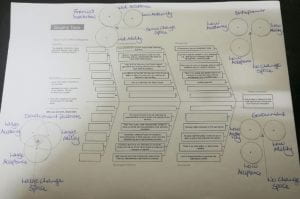Guest blog written by Agnes Manthi, Beatrice Githinji, Constance Gichovi, Peter Onguka
This is a team from Kenya working in the private sector. They successfully completed the 15-week Practice of PDIA online course that ended in December 2018. This is their story.
The course was quite eye-opening to the dynamics in play when it comes to solving problems. Working as a team in this course resulted in a lot of learning from the different modules at every level of the PDIA problem solving approach. Some of these key takeways include:
- Problem construction – the team was able to understand and appreciate the importance of clearly defining our problem, why it matters, to whom it matters and who else it should care. This helped to be able to start preparing our approach by identifying the people we need in order to solve the problem.
- Problem deconstruction through the fish bone diagram by asking ourselves several why’s made us begin to understand the complexity of the problem and realization that there are more underlying causes than we had earlier thought.
- Change Space identification and finding entry points– this step was more critical for us since it set the wheels in motion and helped us start working on coming up with a strategy with which to start working on finding a solution to our problem. This is because we learnt how to analyze the authorization, capabilities and ability requirements around our sub causes (identified through problem deconstruction) and identified where we had change space and what we had to do to create some change space if need be.

- Group Dynamics – we learnt that forming group norms at the beginning when working in teams is important and evaluating and re-evaluating these norms along the way helps to check in and see if the group is doing well. The course provided first-hand experience of challenges encountered in the different group stages and ways in which to overcome any storms that may arise. The realization that other groups experienced similar challenges was in itself great motivation to keep going.
We were able to gain a deeper understanding of our problem, identified the sub-causes and developed strategies on how to solve each of them bearing in mind that: to solve some sub-causes would require more effort and engagement. We were also able to identify the authorizers, capabilities required and accetances required to develop and implement solutions to our problem agencies and authorizers that we needed to help in finding solutions to our problem.

The team, during the first iteration, started working on the identified sub-cause and approached the different authorizers in the organizations we selected to work with and started conversations about our idea. The financial institutions were open to work with us and asked the team to come up with a concept note detailing our pitch.
During the first iteration, the team was able to drop one of the earlier identified financial institutions as it was noted it was not a good fit for our project.
Insights
The biggest insight we got from this course was the realization that our problem was more complex than we had initially thought. The fish bone diagram revealed there is significant political influence in our problem making it a complex one.
The iteration approach to solving problems is already proving to be effective. Through setting small short-term activities and check ins, the team has been able to identify learnings and obstacles and re-strategize to ensure that the process is not stalled.
We have engaged the stakeholders involved and with lessons from the course we have come up with a plan on how to work on this for the next month.
Lessons learnt will be used to solve problems in our day to day lives both at work and at home. E.g Training children on various things around the house can be quite challenging and requires patience. The iteration approach can be used to encourage use of small achievable activities with regular check ins to monitor progress and learnings.
The PDIA approach fosters a lot of learning and we will apply this in sharing tacit knowledge. For example, encouraging a working environment where tacit knowledge can be passed on through, on job training and mentorship at our work places.
To learn more, visit our website or download the PDIAtoolkit (available in English and Spanish).